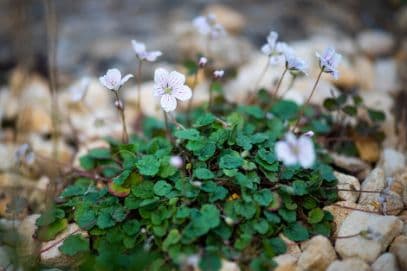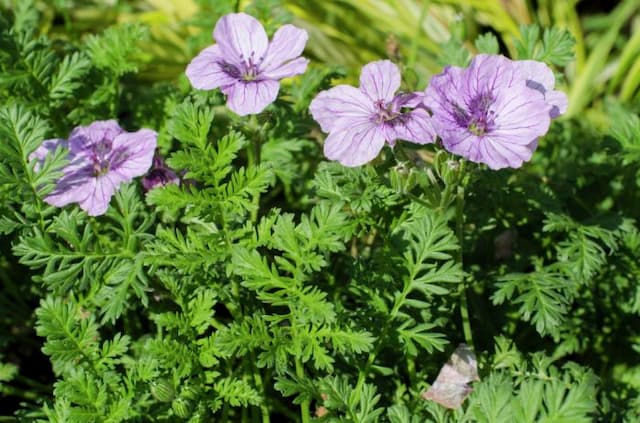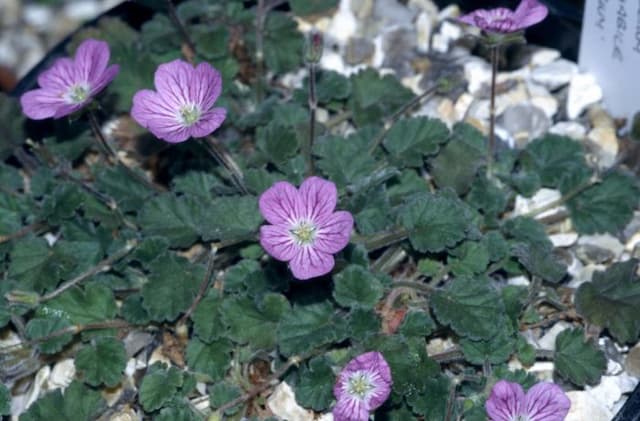Meadow cranesbill Geranium pratense

ABOUT
G. pratense is a clump-forming perennial with hairy stems and deeply-lobed foliage. The saucer-shaped, white, blue or violet flowers are 4cm across and appear in early to mid-summer
About this plant
 Names
NamesFamily
Geraniaceae.
Synonyms
Meadow Crane's-bill, Meadow Geranium.
Common names
Geranium hungaricum, Geranium lancastriense, Geranium latifolium, Geranium sylvaticum var. lancastriense, Geranium sylvaticum var. pratense.
 Characteristics
CharacteristicsLife cycle
Perennials
Foliage type
Deciduous
Color of leaves
Varies
Flower color
Varies
Height
2-3 feet (60-90 cm)
Spread
1-2 feet (30-60 cm)
Plant type
Herb
Hardiness zones
5
Native area
Europe
Benefits
 General Benefits
General Benefits- Attracts Pollinators: Geranium pratense is known to attract bees and butterflies, which are beneficial for pollinating gardens and supporting local ecosystems.
- Aesthetic Appeal: With its striking blue flowers, Geranium pratense, commonly known as meadow cranesbill, adds vibrant color and beauty to gardens and landscapes.
- Wildlife Habitat: It provides shelter and breeding spots for various insects, which in turn can be a food source for birds and other wildlife.
- Drought Tolerance: Once established, meadow cranesbill is relatively drought-tolerant, making it suitable for gardens in drier climates or water-wise landscapes.
- Low Maintenance: This perennial plant is generally low-maintenance, requiring minimal care once established in the appropriate environment.
- Soil Erosion Control: The plant's root system can help stabilize soil, reducing erosion in garden settings, particularly on slopes or banks.
 Medical Properties
Medical Properties- Anti-inflammatory: Geranium pratense has been traditionally used to help reduce inflammation.
- Astringent: The plant is known for its astringent properties, which can help tighten and tone the skin and mucous membranes.
- Diuretic: It may promote the production of urine, helping in the elimination of waste from the body.
- Hemostatic: Geranium pratense is sometimes used for its blood-stopping properties, which can help in controlling bleeding.
- Antibacterial: The plant has been reported to possess antibacterial properties that may inhibit the growth of certain bacteria.
- Vulnerary: It is known to aid in wound healing when applied topically.
 Air-purifying Qualities
Air-purifying QualitiesThis plant is not specifically known for air purifying qualities.
 Other Uses
Other Uses- Ink Production: The deep blue-violet flowers of Geranium pratense can be used to make a natural ink or dye for art and craft projects.
- Flower Arrangements: Geranium pratense's attractive flowers and foliage make it a popular choice for fresh or dried floral arrangements.
- Fabric Dye: The petals can be used in dye baths to impart color to fabrics, yielding a range of purples and blues.
- Culinary Garnish: The flowers are edible and can be used as a decorative and flavorful garnish in salads and desserts.
- Natural Pest Deterrent: The plant is sometimes used in companion planting as it is believed to help repel certain types of beetles and other garden pests.
- Ground Cover: Due to its spreading habit, it can be used as a low-maintenance ground cover, providing erosion control on slopes and banks.
- Wildlife Habitat: It provides food for various pollinators, such as bees and butterflies, which makes it valuable for biodiversity in gardens.
- Photography: Because of its striking appearance when in bloom, it's a popular subject for botanical photography.
- Education: Geranium pratense can be used in educational settings to teach botany and the importance of native wildflowers in ecosystems.
- Eco-Friendly Confetti: The petals can be dried and used as a biodegradable confetti alternative for celebrations.
Interesting Facts
 Feng Shui
Feng ShuiMeadow cranesbill is not used in Feng Shui practice.
 Zodiac Sign Compitability
Zodiac Sign CompitabilityMeadow cranesbill is not used in astrology practice.
 Plant Symbolism
Plant Symbolism- True Friendship: Geranium pratense, commonly known as Meadow Cranesbill, often symbolizes strong bonds of friendship thanks to its hardy and reliable nature.
- Good Health: The plant's use in traditional medicine to promote wellbeing and treat various ailments contributes to its association with good health.
- Ingenuity: The adaptability and resourcefulness of the plant in different environments reflect traits of ingenuity and clever problem-solving.
- Foresight: Its tendency to spread and prepare for future growth can be interpreted as a sign of foresight and planning.
- Unexpected Happiness: Sometimes, the bright and cheerful flowers are seen as a symbol of pleasant surprises and unexpected joy.
 Water
WaterMeadow cranesbill, commonly known as Geranium pratense, should be watered deeply once a week, ensuring the soil is moistened but not waterlogged. During hot, dry periods, watering frequency should increase to twice a week. Each watering session should provide enough water to soak the soil to a depth of about 6 inches; this typically equates to about 1 to 1.5 gallons depending on soil type and weather conditions. Overwatering can cause root rot, so it is crucial to allow the soil to dry out slightly between watering sessions. In the winter, when the plant is dormant, reduce watering significantly to prevent the soil from remaining too damp.
 Light
LightMeadow cranesbill thrives in a spot with full sun to partial shade. It prefers to receive at least 4 to 6 hours of sunlight a day but also benefits from some afternoon shade in warmer climates to protect its leaves from scorching. The ideal location would be one where it can bask in the morning sun and then enjoy some relief from the intense midday and afternoon sunlight.
 Temperature
TemperatureMeadow cranesbill is hardy and can withstand a range of temperatures. It grows best in areas where the average temperature is between 65°F and 75°F. The plant can survive minimum temperatures down to about -30°F and maximum temperatures of about 85°F, although prolonged exposure to extremes can be detrimental to its health.
 Pruning
PruningPruning Meadow cranesbill encourages new growth and a bushier plant. After the first flush of flowers has faded, cut back the plant by half to stimulate a second blooming period. This is typically done in midsummer. Deadheading spent flowers regularly also promotes continuous blooming. Annual pruning should occur in late fall or early spring to remove dead and overgrown stems.
 Cleaning
CleaningAs needed
 Soil
SoilMeadow Cranesbill, commonly known as Geranium pratense, thrives in fertile, well-draining soil with a pH range of 5.8 to 7.2. A good soil mix could be composed of two parts garden compost, one part loam, and one part coarse sand or perlite for drainage. Regular mulching with organic matter can help maintain the ideal soil conditions for this hardy perennial.
 Repotting
RepottingMeadow Cranesbill should be repotted when it outgrows its current container, which typically is every 2-3 years. Division of the plant during repotting can encourage vigorous growth and prevent overcrowding. Early spring or fall is the best time to repot this plant, taking care to disturb the roots as little as possible.
 Humidity & Misting
Humidity & MistingMeadow Cranesbill is tolerant of a wide range of humidity levels and does not require any special humidity conditions to thrive. As a hardy perennial, it adapts well to outdoor ambient humidity and does not have specific humidity requirements for healthy growth.
 Suitable locations
Suitable locationsIndoor
Provide bright light, cool temperatures, and well-draining soil.
Outdoor
Plant in partial sun, and well-drained soil; mulch seasonally.
Hardiness zone
4-8 USDA
 Life cycle
Life cycleThe life of a Meadow Cranesbill (Geranium pratense) begins with seed germination, typically in early spring when soil temperatures rise and moisture is plentiful. The seeds produce small seedlings that establish a rosette of leaves close to the ground. As the plant matures, it develops a strong root system and a flowering stem, with leaves growing along the stems. By late spring to early summer, the Meadow Cranesbill blooms, producing distinctive blue to violet flowers that attract pollinators for fertilization. After pollination, the flowers develop into beak-like seed capsules which, upon ripening, release the seeds for dispersal. The plant then goes through a period of dormancy in winter, only to begin the cycle again the following spring.
 Propogation
PropogationPropogation time
Spring to Summer
Propogation: Geranium pratense, commonly known as Meadow Cranesbill, can be propagated by seed, division, or cuttings, but one of the most popular methods is by division. The best time for division is either in the spring as new growth appears, or in the fall when the plant's growth has slowed down. To propagate by division, gently lift the plant from the ground with a garden fork, being careful to keep as much of the root system intact as possible. Then, using your hands or a sharp knife, divide the plant into smaller sections, each with a portion of the roots and several shoots. Replant these divisions immediately, keeping the original soil level consistent, and water them thoroughly. They should be spaced about 12 to 24 inches (approximately 30 to 61 centimeters) apart to ensure ample room for growth.





![Cranesbill [Blue Sunrise]](/_next/image?url=https%3A%2F%2Fplants-admin.emdemapps.com%2Fimages%2Fplants%2F%2Fimages%2F604b638d45948.png&w=640&q=75)



